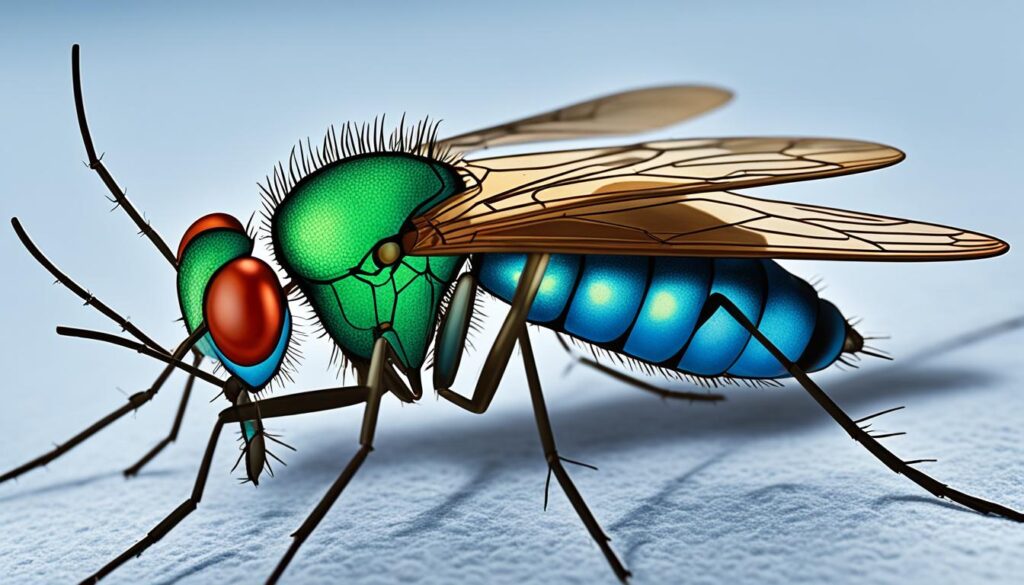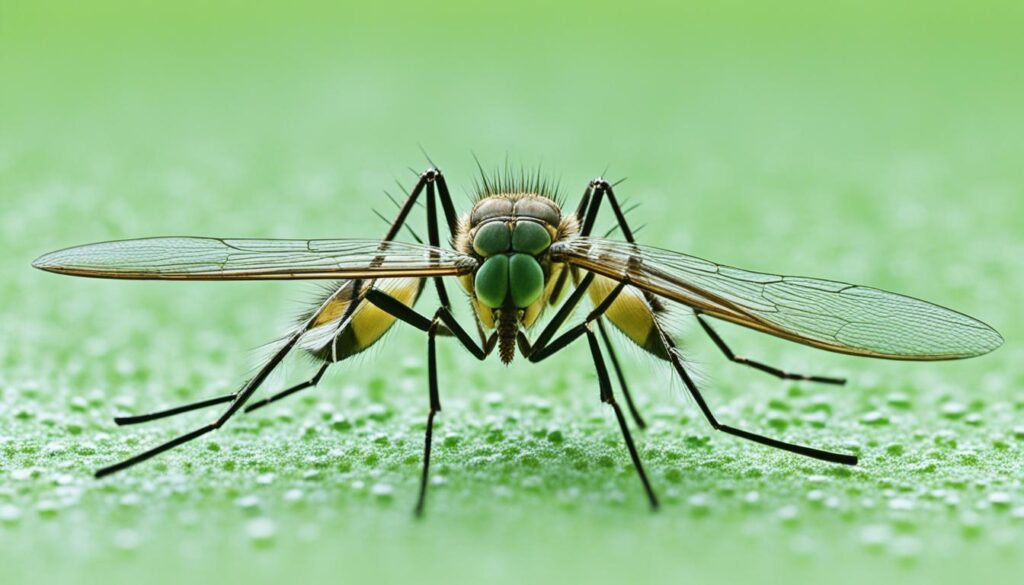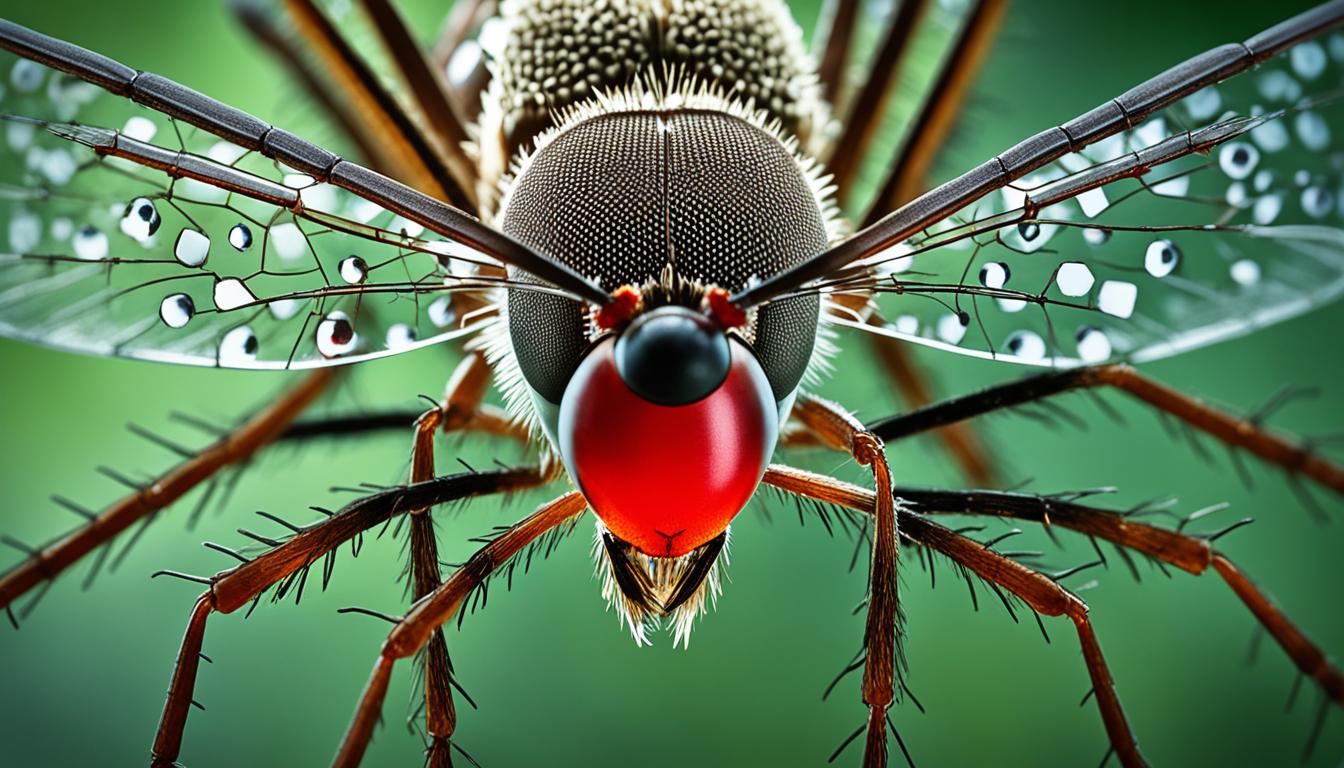Have you ever swatted at a mosquito and wondered about its eyes? Mosquitoes are small but amazing creatures. They can detect and feed on humans and animals easily. Even though they’re tiny, they have a unique structure that helps them thrive.
Mosquitoes have a special kind of vision that helps them find their next meal. We’ll look at how their eyes work and learn some cool facts about them.
Key Takeaways
- Mosquitoes have two compound eyes, one on each side of their head.
- Each compound eye is made up of hundreds of small lenses called ommatidia, allowing mosquitoes to see in multiple directions and detect movement.
- Mosquitoes perceive the world in black and white, focusing on shapes and outlines rather than detailed color vision like humans.
- Mosquitoes have excellent night vision, able to detect objects in low light conditions better than humans.
- Understanding mosquito vision is key to developing effective mosquito control and repellent strategies.
Introduction to Mosquito Vision
Mosquitoes, much like other insects, have a special way of seeing the world. They rely on their eyes to survive and behave. Each mosquito has two eyes on each side of its head. These eyes are made of thousands of tiny parts called ommatidia. They let mosquitoes see in many directions at once, giving them a wide view of the world around them.
Compound Eyes and Ommatidia
The eyes of mosquitoes are made of many ommatidia. These each have cells that can sense light. This setup lets mosquitoes get information from lots of different angles. Seeing from many angles helps them understand the shape, movement, and color of things. This way of seeing is key to how mosquitoes live and survive.
Importance of Vision for Mosquitoes
Mosquitoes depend a lot on their sight, smell, and heat sense. They use these to find their next meal and avoid danger. Their eyes help them spot people, animals, and good places to breed. This ability is crucial for their life and habits.
Learning about how mosquitoes see can show us ways to deal with them. This knowledge can help fight the danger they bring.
How Many Eyes Does a Mosquito Have?
Mosquitoes are not just bugs; they are master hunters with many skills. Their eyes play a big role in their hunting. They have two large compound eyes, one on each side of the head.
These eyes are like a bunch of tiny cameras. They are called ommatidia. With these, mosquitoes can keep a lookout in many directions at the same time.
Why do they need to see so well? It’s because they’re always looking for a meal. Apart from their big compound eyes, mosquitoes have special eyes on top called ocelli. These detect light changes and help them in the dark, finding their next meal.
- Mosquitoes have two large compound eyes, one on each side of their head.
- Each compound eye is made up of thousands of tiny ommatidia.
- This eye design allows for a very wide field of vision, crucial for their survival.
- They also have light-detecting eyes called ocelli, aiding in finding hosts.
With a mix of compound and photosensitive eyes, mosquitoes get a full view. This makes them very good at finding hosts. Understanding how mosquitoes see helps us figure out how to deal with them better.

Experts at MosquitoNix offer ways to control these pests. By learning about mosquito eyes and overall anatomy, we can protect ourselves from their bites more effectively.
Mosquito Anatomy: Exploring Their Compound Eyes
Mosquitoes have compound eyes that give them a special way of seeing the world. Their eyes have lots of tiny lenses, each with cells that react to light. This lets mosquitoes see not just straight ahead, but all around them at the same time.
Structure of Compound Eyes
A mosquito has many tiny lenses, called ommatidia, on its eyes. These are set up in a hexagonal shape. This design gives mosquitoes a big scope of vision. Their eyes are a great example of how bugs’ eyes have adapted over time.
Function of Ommatidia
The ommatidia help mosquitoes spot movement, shapes, and silhouettes. They don’t see sharp, clear images like us but use their vision to fly well, find meals, and stay safe. This kind of vision is key for mosquitoes to live and do their daily activities.
| Mosquito Anatomical Feature | Description |
|---|---|
| Compound Eyes | Composed of numerous small, hexagonal lenses called ommatidia |
| Ommatidia | Light-sensitive cells that work together to form a composite image |
| Visual Perception | Specialized for detecting movement, shapes, and outlines |
Mosquito Senses: Vision, Smell, and Heat Detection
Mosquitoes use different senses to find and bite us. They see well, smell us from far, and feel our heat. This helps them target us better.
Vision is key for mosquitoes, letting them see movement up to 50 feet away. Their eyes have many lenses, allowing a wide view and sharp detection of shapes and motion.
Smell plays a big role too. Females smell carbon dioxide (CO2) to find people from 100 feet away. They’re especially attracted to Type O blood and alcohol.
They can also sense body heat. This helps them find targets up close. They can find us even without seeing or smelling us directly, like in the dark.
Understanding how mosquitoes find us can help avoid their bites. Using mosquito barrier sprays and wearing light clothes are good steps. Also, try not to raise your body heat or CO2 too much.
Vision Capabilities of Mosquitoes
Mosquitoes have amazing eyesight, especially when it’s not very bright. Each eye is made of many small parts that can see light. They can sense very small movements and know the shape of things very well. This is very important for mosquitoes. They look for people or animals to bite at early morning, evening, or during the night, when it’s dark.
Seeing in Low Light Conditions
Although mosquitoes can’t see details clearly, they are very good at seeing in the dark. Their eyes are built to use even a little bit of light well. This helps them fly and find people or animals to bite, mainly when it’s getting dark. So, this special sight is a big advantage for mosquitoes.
Detecting Movement and Shapes
Mosquitoes’ eyes not only work in the dark but also notice movement really well. They can follow tiny movements of their target. This skill is key for them to land and take a bite. Also, they can recognize shapes, which lets them pick out who to bite and where to lay their eggs.
Mosquitoes see the world in an extraordinary way, adapting over time to find and feed off people and animals around them effectively. Studying how mosquitoes see can give us clues to understand their actions better. This, in turn, could help us create better ways to manage mosquitoes.

| Statistic | Value |
|---|---|
| Mosquito species | Approximately 3,500 |
| Anopheles mosquitoes | Carriers of malaria, filariasis, and encephalitis |
| Culex mosquitoes | Transmit viral encephalitis and filariasis |
| Aedes mosquitoes | Carry pathogens responsible for yellow fever, dengue, Zika fever, and encephalitis |
| Anopheles life cycle | 18 days to several weeks |
| Culex life cycle | 10 to 14 days, may be longer in cold weather |
| Aedes life cycle | 10 days to several months |
How Mosquitoes Locate Hosts Using Vision
Mosquitoes are very good at finding people they can bite. They use their eyes, noses, and the heat people give off to track down targets. Their smell helps them find the carbon dioxide that people breathe out and other smells. But, their eyes are also essential for finding what they need to eat.
Role of Vision in Host Detection
New studies show how important the eyes of mosquitoes are for finding people to bite. The Aedes aegypti mosquitoes, in particular, are attracted to the reddish-orange signals from human skin. This is true for all skin colors. So, what you wear and your skin color can affect if mosquitoes find you appealing.
Attraction to Certain Colors
Aedes aegypti mosquitoes like certain colors more than others. They love red, orange, black, and cyan. But, they tend to ignore colors like green, purple, blue, and white. Their love for certain colors is tied to their ability to spot the red-orange signals our skin gives off. It helps them find hosts to feed on.
To avoid being a mosquito target, knowing about their color and vision is useful. Staying away from colors mosquitoes like can make you less appealing. Using bug sprays can also lower your chances of getting bitten.
Scientists are still looking into how mosquitoes use their senses to find and bite people. They are studying how mosquitoes’ eyes, noses, and feeling for heat work together. Their goal is to find better ways to control these insects. This would help lessen diseases mosquitoes can spread.
Mosquito Vision Myths and Facts
Many myths surround mosquito vision. It’s crucial to know the facts to understand these insects better. Let’s look at some common myths and the actual truth behind them.
Myth: Mosquitoes are only active at dusk or dawn.
Mosquitoes are active at various times, including daytime and night. Some prefer twilight, but many are out all day and night. Their patterns are not just limited to dusk or dawn hours.
Myth: Mosquitoes are drawn to certain individuals due to their vision.
Mosquitoes find their meals using sight, smell, and heat. Only some people are bitten more due to their body heat or skin bacteria. Their attraction is not solely based on what they see.
Fact: Mosquitoes have compound eyes with thousands of individual light-sensing units.
These insects have compound eyes made of units called ommatidia. This design gives mosquitoes a detailed view of the world around them.
Fact: Mosquitoes can detect movement and shapes, but their visual acuity is relatively low.
Despite not having great vision, mosquitoes can spot movement and shapes. This, mixed with other senses, guides them to their hosts.
Understanding how mosquitoes see can help us control their numbers and lower the risk of diseases they spread.
| Mosquito Vision Myths | Mosquito Vision Facts |
|---|---|
|
|
Avoiding Mosquito Bites: Best Practices
Mosquitoes are great at spotting us, but we can outsmart them. Wear the right protective clothing and use the best mosquito repellents to stay safe. This way, you lower the risk of getting bitten.
First off, choose loose clothes in light colors. Mosquitoes find these colors and tight clothing less attractive. Also, think about treating your clothes with permethrin. Clothes treated with it can keep you safe for many washes.
When picking mosquito repellents, ones with DEET, picaridin, or oil of lemon eucalyptus work well. DEET is known to be very effective and can protect for up to 10 hours. Picaridin and oil of lemon eucalyptus are good choices, too.
Knowing when mosquitoes are active is key. They are most lively at dawn and dusk. So, avoiding these times outside can help. If you sleep outdoors, using a mosquito net can add extra protection.
Keeping mosquitoes away from your home is also crucial. Get rid of standing water, like in birdbaths or flowerpots, as this water attracts mosquitoes. By doing this, you lower the number of mosquitoes around you.
By using these strategies, you can stay away from mosquito bites. This way, you can have fun and not worry so much about these pests bothering you or bringing health risks.
Conclusion
Mosquitoes are fascinating creatures known for their keen vision. This helps them find and feed on hosts. Understanding how mosquitoes see, with their compound eyes and ommatidia, sheds light on their success as pests.
Despite their advanced vision skills, avoiding mosquito bites is possible. Stay informed and wear protective gear. Using trusted repellents helps keep mosquitoes at bay, letting you enjoy the outdoors without worry.
Research on mosquito vision and their abilities offers insights for pest control. This helps prevent diseases they carry. Staying alert and taking preventive steps ensures your outdoor time is enjoyable, mosquito-free.
